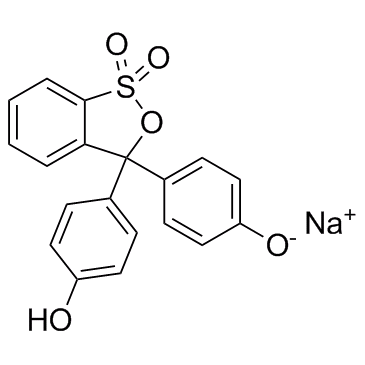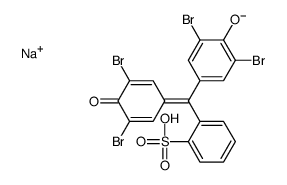34487-61-1
| Name | sodium,4-[3-(4-hydroxyphenyl)-1,1-dioxo-2,1λ6-benzoxathiol-3-yl]phenolate |
|---|---|
| Synonyms |
Phenolsulfonephthalein sodium salt
Phenol Red,sodium salt PR sodium salt phenolsulfonphthalein sodium salt phenolsulphophthaleine sodium salt UNII-50J9732WBG MFCD00066901 Phenol, 4,4'-(1,1-dioxido-3H-2,1-benzoxathiol-3-ylidene)bis-, monosodium salt EINECS 252-057-8 phenolsulfonephthalein sodium Sodium 4-(3-(4-hydroxyphenyl)-1,1-dioxido-3H-benzo[c][1,2]oxathiol-3-yl)phenolate Phenolate, 4,4'-(1,1-dioxido-3H-2,1-benzoxathiol-3-ylidene)bis-, sodium salt (1:1) phenol red sodium salt PHENOL RED,ACS Sodium Phenol Red sodium hydrogen 4,4'-(3H-2,1-benzoxathiol-3-ylidene)bisphenolate S,S-dioxide Phenol Red (sodium salt) |
| Description | Phenol Red sodium salt is a water soluble pH indicator used in the 6.8 (yellow) to 8.2 (red) range. |
|---|---|
| Related Catalog | |
| In Vitro | Phenol Red sodium salt is commonly employed as a cell tissue culture pH marker. Under normal conditions, phenol red added to the growth medium will have a pink-red color. Dying cells or overgrowth of contaminants will cause a change in pH resulting in a change in indicator color. Phenol red bears a structural resemblance to some nonsteroidal estrogens and has significant estrogenic activity at the concentrations (15-45 μM) at which it is found in tissue culture media. Phenol red binds to the estrogen receptor of MCF-7 human breast cancer cells and stimulates the proliferation of estrogen receptor-positive MCF-7 breast cancer cells in a dose-dependent manner but has no effect on the growth of estrogen receptor-negative MDA-MB-231 breast cancer cells[1]. Phenol red is a simple, rapid and inexpensive method for the measurement of hydrogen peroxide produced by cells in culture. The assay is based on the horseradish peroxidase-mediated oxidation of phenol red by hydrogen peroxide which results in the formation of a compound demonstrating increased absorbance at 610 nm[2]. |
| Cell Assay | Phenol red is dissolved in 0.1% ethanol. To determine the effect of phenol red on cell proliferation, MCF-7 cells grown for 1 week before experiments in phenol red-free MEM supplemented are harvested and seeded into T-25 flasks (ca. 1.5 x 105 cells per flask). The following day, cells from three flasks are harvested and counted with a Coulter Counter. Then the medium is changed to phenol red- and insulin-free MEM, which contains various concentrations of dextran-coated charcoal-treated calf serum, phenol red (0-300 μM), tamoxifen, hydroxytamoxifen, estradiol, or ethanol vehicle (0.1%), and cell number is monitored as a function of time[1]. Phenol Red sodium salt is dissolved in distilled water as a 10 g/L stock solution[2]. |
| References |
| Density | 0.972 |
|---|---|
| Boiling Point | 562.8ºC at 760mmHg |
| Melting Point | 285 °C (dec.)(lit.) |
| Molecular Formula | C19H13NaO5S |
| Molecular Weight | 375.351 |
| Flash Point | 294.2ºC |
| Exact Mass | 375.030853 |
| PSA | 95.04000 |
| LogP | 4.62760 |
| Storage condition | Store at RT. |
| Stability | Stable. Incompatible with strong oxidizing agents. |
| Water Solubility | soluble |
| Symbol |

GHS07 |
|---|---|
| Signal Word | Warning |
| Hazard Statements | H315-H319-H335 |
| Precautionary Statements | P261-P305 + P351 + P338 |
| Personal Protective Equipment | dust mask type N95 (US);Eyeshields;Gloves |
| Hazard Codes | Xi:Irritant; |
| Risk Phrases | R36/37/38 |
| Safety Phrases | S26-S36-S37/39 |
| RIDADR | NONH for all modes of transport |
| WGK Germany | 3 |
| HS Code | 29349990 |
| Precursor 0 | |
|---|---|
| DownStream 1 | |
| HS Code | 29349990 |
|---|



